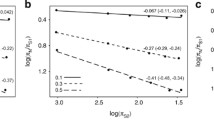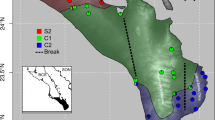Abstract
Accurate estimation of relative mutation rates of mitochondrial DNA (mtDNA) and single-copy nuclear DNA (scnDNA) within lineages contributes to a general understanding of molecular evolutionary processes and facilitates making demographic inferences from population genetic data. The rate of divergence at synonymous sites (K s) may be used as a surrogate for mutation rate. Such data are available for few organisms and no amphibians. Relative to mammals and birds, amphibian mtDNA is thought to evolve slowly, and the K s ratio of mtDNA to scnDNA would be expected to be low as well. Relative K s was estimated from a mitochondrial gene, ND2, and a nuclear gene, c-myc, using both “approximate” and likelihood methods. Three lineages of congeneric frogs were studied and this ratio was found to be approximately 16, the highest of previously reported ratios. No evidence of a low K s in the nuclear gene was found: c-myc codon usage was not biased, the K s was double the intron divergence rate, and the absolute K s was similar to estimates obtained here for other genes from other frog species. A high K s in mitochondrial vs. nuclear genes was unexpected in light of previous reports of a slow rate of mtDNA evolution in amphibians. These results highlight the need for further investigation of the effects of life history on mutation rates.


Similar content being viewed by others
References
WR Atchley WM Fitch (1995) ArticleTitleMyc and Max: molecular evolution of a family of proto-oncogene products and their dimerization partner. Proc Natl Acad Sci USA 92 10217–10221 Occurrence Handle1:CAS:528:DyaK2MXovFalsLs%3D Occurrence Handle7479755
AM Báez (1996) The fossil record of the Pipidae. RC Tinsley HR Kobel (Eds) The biology of Xenopus. Oxford University Press New York 329–347
F Bossuyt MC Milinkovitch (2000) ArticleTitleConvergent adaptive radiations in Madagascan and Asian ranid frogs reveal covariation between larval and adult traits. Proc Nat Acad Sci USA 97 6585–6590 Occurrence Handle10.1073/pnas.97.12.6585 Occurrence Handle1:CAS:528:DC%2BD3cXktFaju74%3D Occurrence Handle10841558
WM Brown M George Jr AC Wilson (1979) ArticleTitleRapid evolution of animal mitochondrial DNA. Proc Natl Acad Sci USA 76 1967–1971 Occurrence Handle1:CAS:528:DyaE1MXktVWmsb8%3D Occurrence Handle109836
K Burke (1988) ArticleTitleTectonic evolution of the Caribbean. Annu Rev Earth Planet Sci 16 201–230 Occurrence Handle10.1146/annurev.ea.16.050188.001221
JM Comeron (1995) ArticleTitleA method for estimating the numbers of synonymous and nonsynonymous substitutions per site. J Mol Evol 41 1152–1159 Occurrence Handle1:CAS:528:DyaK28XivFOnsQ%3D%3D Occurrence Handle8587111
JM Comeron (1999) ArticleTitleK-Estimator: Calculation of the number of nucleotide substitutions per site and the confidence intervals. Bioinformatics 15 763–764 Occurrence Handle1:CAS:528:DyaK1MXnt1Cks7g%3D Occurrence Handle10498777
AJ Crawford (2003) ArticleTitleHuge populations and old species of Costa Rican and Panamanian dirt frogs inferred from mitochondrial and nuclear gene sequences. Mol Ecol 12 2525–2540 Occurrence Handle10.1046/j.1365-294X.2003.01910.x Occurrence Handle1:STN:280:DC%2BD3svivFKktg%3D%3D Occurrence Handle12969459
MA Donnelly (1999) ArticleTitleReproductive phenology of Eleutherodactylus bransfordii in northeastern Costa Rica. J Herpetol 33 624–631
WE Duellman JB Pramuk (1999) ArticleTitleFrogs of the genus Eleutherodactylus (Anura: Leptodactylidae) in the Andes of northern Peru. Sci Papers Nat Hist Mus Univ Kans 13 1–78
N Goldman Z Yang (1994) ArticleTitleA codon-based model of nucleotide substitution for protein-coding DNA sequences. Mol Biol Evol 11 725–736 Occurrence Handle7968486
MA Iturralde-Vinent RDE MacPhee (1999) ArticleTitlePaleogeography of the Caribbean region: Implications for Cenozoic biogeography. Bull Am Mus Nat Hist 238 1–95
KP Johnson DH Clayton (2000) ArticleTitleNuclear and mitochondrial genes contain similar phylogenetic signal for pigeons and doves (Aves: Columbiformes). Mol Phylogenet Evol 14 141–151 Occurrence Handle10.1006/mpev.1999.0682 Occurrence Handle1:CAS:528:DC%2BD3cXisFemsA%3D%3D Occurrence Handle10631048
M Kimura (1983) The neutral theory of molecular evolution. Cambridge University Press Cambridge
JD Lynch (2000) ArticleTitleThe relationships of an ensemble of Guatemalan and Mexican frogs (Eleutherodactylus: Leptodactylidae: Amphibia). Rev Acad Colomb Cienc 24 67–94 Occurrence Handle1:STN:280:BiyC1MrgtlU%3D Occurrence Handle6573657
JD Lynch WE Duellman (1997) ArticleTitleFrogs of the genus Eleutherodactylus in western Ecuador. Univ Kans Nat Hist Mus Spec Pub 23 1–236
JR Macey A Larson NB Ananjeva Z Fang TJ Papenfuss (1997) ArticleTitleTwo novel gene orders and the role of light-stand replication in rearrangement of the vertebrate mitochondrial genome. Mol Biol Evol 14 91–104 Occurrence Handle1:CAS:528:DyaK2sXjvFyisw%3D%3D Occurrence Handle9000757
JR Macey JA Schulte II A Larson Z Fang Y Wang BS Tuniyev TJ Papenfuss (1998) ArticleTitlePhylogenetic relationships of toads in the Bufo bufo species group from the eastern escarpment of the Tibetan Plateau: A case of vicariance and dispersal. Mol Phylogenet Evol 9 80–87 Occurrence Handle10.1006/mpev.1997.0440 Occurrence Handle1:CAS:528:DyaK1cXht1yhurk%3D Occurrence Handle9479697
AP Martin (1999) ArticleTitleSubstitution rates of organelle and nuclear genes in sharks: Implicating metabolic rate (again). Mol Biol Evol 16 996–1002 Occurrence Handle1:CAS:528:DyaK1MXksFOlsLw%3D Occurrence Handle10406116
AP Martin SR Palumbi (1993) ArticleTitleBody size, metabolic rate, generation time, and the molecular clock. Proc Natl Acad Sci USA 90 4087–4091 Occurrence Handle1:CAS:528:DyaK3sXkt1ehs7o%3D
AP Martin GJP Naylor SR Palumbi (1992) ArticleTitleRate of mitochondrial DNA evolution is slow in sharks compared to mammals. Nature 357 153–155 Occurrence Handle1:CAS:528:DyaK38XktVCmtLg%3D Occurrence Handle1579163
T Miyata H Hayashida R Kikuno M Hasegawa M Kobayashi K Koike (1982) ArticleTitleMolecular clock of silent substitution: at least six-fold preponderance of silent changes in mitochondrial genes over those in nuclear genes. J Mol Evol 19 28–35 Occurrence Handle1:CAS:528:DyaL3sXms1Cmsw%3D%3D Occurrence Handle7161808
EN Moriyama JR Powell (1997) ArticleTitleSynonymous substitution rates in Drosophila: Mitochondrial versus nuclear genes. J Mol Evol 45 378–391 Occurrence Handle1:CAS:528:DyaK2sXms1Wmur4%3D Occurrence Handle9321417
SR Palumbi (1989) ArticleTitleRates of molecular evolution and the fraction of nucleotide positions free to vary. J Mol Evol 29 180–187 Occurrence Handle1:CAS:528:DyaL1MXkvFansL0%3D Occurrence Handle2509718
G Pesole C Gissi A De Chirico C Saccone (1999) ArticleTitleNucleotide substitution rate of mammalian mitochondrial genomes. J Mol Evol 48 427–434 Occurrence Handle1:CAS:528:DyaK1MXhvFyqu7w%3D Occurrence Handle10079281
JR Powell A Caccone GD Amato C Yoon (1986) ArticleTitleRates of nucleotide substitution in Drosophila mitochondrial DNA and nuclear DNA are similar. Proc Natl Acad Sci USA 83 9090–9093 Occurrence Handle1:CAS:528:DyaL2sXjtVeisA%3D%3D Occurrence Handle3097641
TM Prychitko WS Moore (2000) ArticleTitleComparative evolution of the mitochondrial cytochrome b gene and nuclear β-fibrinogen intron 7 in woodpeckers. Mol Biol Evol 17 1101–1111 Occurrence Handle1:CAS:528:DC%2BD3cXksVOlsr0%3D Occurrence Handle10889223
DM Rand (1994) ArticleTitleThermal habit, metabolic rate and the evolution of mitochondrial DNA. Trends Ecol Evol 9 125–131 Occurrence Handle10.1016/0169-5347(94)90176-7
DE Rosen (1976) ArticleTitleA vicariance model of Caribbean biogeography. Syst Zool 24 431–464
J Rozas R Rozas (1999) ArticleTitleDnaSP version 3: an integrated program for molecular population genetics and molecular evolution analysis. Bioinformatics 15 174–175 Occurrence Handle10.1093/bioinformatics/15.2.174 Occurrence Handle1:CAS:528:DyaK1MXisVOksrY%3D Occurrence Handle10089204
JM Savage (1966) ArticleTitleThe origins and history of the Central American herpetofauna. Copeia 1966 719–766
JM Savage (1982) ArticleTitleThe enigma of the Central American herpetofauna: Dispersals or vicariance? Ann Mo Bot Gard 69 464–547
PM Sharp W-H Li (1989) ArticleTitleOn the rate of DNA sequence evolution in Drosophila. J Mol Evol 28 398–402 Occurrence Handle1:CAS:528:DyaL1MXit1yrs78%3D Occurrence Handle2501501
FH Sheldon CE Jones KG McCracken (2000) ArticleTitleRelative patterns and rates of evolution in heron nuclear and mitochondrial DNA. Mol Biol Evol 17 437–450 Occurrence Handle1:CAS:528:DC%2BD3cXhvVahsL0%3D Occurrence Handle10723744
RW Slade C Moritz A Heideman (1994) ArticleTitleMultiple nuclear-gene phylogenies: Application to pinnipeds and comparison with a mitochondrial DNA gene phylogeny. Mol Biol Evol 11 341–356 Occurrence Handle1:CAS:528:DyaK2cXksl2hu70%3D Occurrence Handle8015430
SM Stigler (1999) Statistics on the table: The history of statistical concepts and methods. Harvard University Press Cambridge, MA
RC Tinsley MJ McCoid (1996) Feral populations of Xenopus outside Africa. RC Tinsley HR Kobel (Eds) The biology of Xenopus. Oxford University Press New York 329–347
L Vawter WM Brown (1986) ArticleTitleNuclear and mitochondrial DNA comparisons reveal extreme rate variation in the molecular clock. Science 234 194–196 Occurrence Handle1:CAS:528:DyaL28XlvVGhsr0%3D Occurrence Handle3018931
F Wright (1990) ArticleTitleThe “effective number of codons” used in a gene. Gene 87 23–29
C-I Wu W-H Li (1985) ArticleTitleEvidence for higher rates of nucleotide substitution in rodents than in man. Proc Natl Acad Sci USA 82 1741–1745 Occurrence Handle1:CAS:528:DyaL2MXhvVSisro%3D Occurrence Handle3856856
Z Yang (2000) Phylogenetic analysis by maximum likelihood (PAML), version 3.0. University College London London
Acknowledgements
Thanks go to E.N. Smith for the samples of the “mexicanus” group and A. Carnaval for the Brazilian sample. Collecting permits were kindly provided by MINAE in Costa Rica and ANAM in Panama. E. Stahl got me fixated on silent site variation. I thank J. Comeron and G. Reeves for help with analyses. Comments on earlier incarnations of this paper were provided by M. Kreitman, M. Wade, J. Comeron, T. Duda, N. Lehman, and two anonymous reviewers. This project was supported by an OTS graduate research fellowship, a STRI-OTS Mellon predoctoral fellowship, Sigma Xi, the ASIH, and the SICB.
Author information
Authors and Affiliations
Corresponding author
Rights and permissions
About this article
Cite this article
Crawford, A.J. Relative Rates of Nucleotide Substitution in Frogs . J Mol Evol 57, 636–641 (2003). https://doi.org/10.1007/s00239-003-2513-7
Received:
Accepted:
Issue Date:
DOI: https://doi.org/10.1007/s00239-003-2513-7




